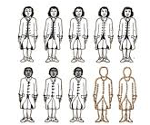The Road to the Civil War
The slave trade flourished once the European powers got involved and only gradually eased. Great Britain and the U.S. abolished the international slave trade in 1807. The domestic slave trade carried on in the U.S., with each state gradually passing its own prohibition of internal slave trading. And it was that slave labor, provided by people who were lucky enough to survive the dreaded Middle Passage across the Atlantic, that was the backbone of the Southern economy. Slave labor powered the production of the tobacco field and the cotton plantation and the rice and indigo fields. Slave labor made the plantations work and the small farms thrive and the households of owners of all of that run. Slaves had few if any rights and could be punished, even severely, or killed. Slavery was accepted as a fact of life by a great many Americans. African slaves were considered less important, less worthy, even less of a person by European-Americans on both sides of the Mason-Dixon Line. In the wake of the authoritarian abuse that the Declaration of Independence charged England's King George III with committing, the 13 Colonies set up a deliberately decentralized government under the Articles of Confederation. One of the prime weaknesses of that governmental blueprint, in practice, was that all laws required the consent of all colonies. Naturally, all laws included laws of taxation, and the loose-framework government needed money to survive. 
The U.S. Government under the Articles of Confederation did collect some taxes and apportioned them according to land value, not population. The trusting government left it up to the individual states to quote their own land values, and so the practice of undervaluing a state's land value was not altogether uncommon. The Continental Congress debated the idea of apportioning taxation according to population but could not come to an agreement because of the thorny issue of whether and how to include enslaved people in the population count. The attendees of the Constitutional Convention did find a way, another compromise, that counted slaves as three-fifths of a person. It was another compromise, one of many that European-Americans made on behalf of or, more accurately, to the detriment of African-Americans. The idea of compromise in order to satisfy both Northern and Southern interests was an idea early adopted. The fiery debates of the Constitutional Convention burned red hot with topics like congressional representation and taxation. The very fabric of the government, with its two houses of Congress and its executive and judicial branches, was the result of a compromise–an overall plan that had enough elements that were palatable to enough people so that enough support was achieved in order to create the government. Another early compromise involved the geographical placement of the capital, Washington, D.C. Alexander Hamilton, the first Secretary of the Treasury, wanted the federal government to take on all debts currently owed by state governments. Hamilton's idea was to roll all of the outstanding state debts into one federal debt and then sell government bonds in order to pay off the debt. Those who would buy such bonds would be more likely to buy them from the newly created Both sides got something that they wanted, and both sides were willing to "give up" something in order to "get" something else. That spirit of compromise, of shared central interest that allowed North and South to effectively agree to disagree on some things as long as they also agreed on the central idea that they were better together than apart, sustained the nation through an intense period of growth. The more tensions ran high, however, the less people were willing to compromise. Eventually, divisions led to dissensions, which led to furious disagreements, which led to violence. Moving west As settlement of the continent spread westward, populations grew, and more and more states petitioned to join the Union, Congress became obsessed with maintaining some semblance of balance between North and South in terms of representation. The Southern states did not all band together on every issue, but they did, more often than not, do so when the issue came to whether to allow slavery, either in existing states or in new ones. The same was true in the North–at least in terms of not all states being in lock step all of the time; however, the issue of whether to allow slavery in new territories was one that generally united Northern interests behind stemming the spread of slavery. Next page > Compromises and Consequences > Page 1, 2, 3 4, 5 |
|
Social Studies for Kids
copyright 2002–2025
David White




 federal government than from a state government, Hamilton reasoned. The proposal met with opposition from first
federal government than from a state government, Hamilton reasoned. The proposal met with opposition from first 
